|
|


Botany
 |
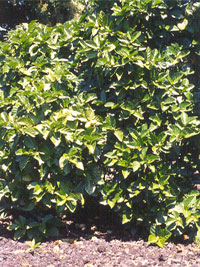 |
Figure 1. Mature noni
(Morinda citrifolia) plant in the Puna district on the island
of Hawai’i.
|
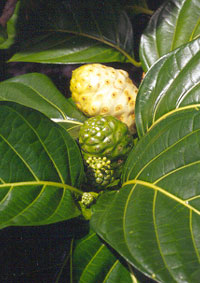 |
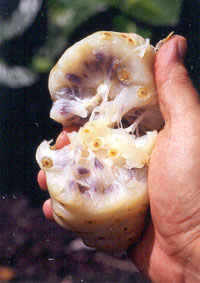 |
Figure 2.
LEFT: Noni fruits (Morinda citrifolia) in various stages of
development, from flowering (foreground) to ripe (background). RIGHT:
Ripe noni fruit with seeds.
|
Noni (Morinda
citrifolia L.) is a member of the Rubiaceae plant family. The
following botanical description of the genus Morinda and two Morinda
species common in Hawaii was reproduced with permission from The
Manual of the Flowering Plants of Hawaii, by Wagner, Herbst and
Sohmer (Copyright 1990, Bishop Museum, Honolulu).
|
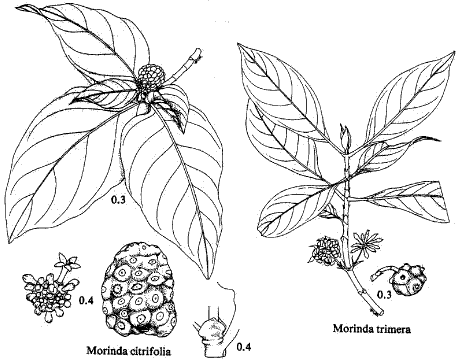
|
|
MORINDA L.
Trees, shrubs, or sometimes lianas. Leaves opposite, pinnately veined,
upper surface often with domatia, lower surface with pubescent domatia
in axils of midrid and lateral veins, stipules interpetiolar, leafy,
distinct or adnate to petioles forming a sheath. Flowers perfect,
heterostylus, or sometimes unisexual, in irregularly globose, ovoid
to ellipsoid heads, bracts small; calyx lobes (2-)4-6, short, usually
truncate, bases connate, rarely with 1-2 leaf-like lobes; corolla
funnel form or salverform, lobes (2-)4-6, valvate in bud, keeled within;
nectary disk annular; stamens inserted on corolla throat, exserted;
anthers dorsi-fixed; ovary 2-celled or incompletely 4-celled, ovules
1 per cell, attached below middle or near base; style dimorphic, 2-branched.
Fruit a drupe, those of the whole inflorescence connate to form a
fleshy or hard syncarp, containing cartilaginous, 1-seeded pyrenes.
Seed 1, obovoid or reniform. [St. John, 19791]
A genus of about 80 species primarily of Old World tropical regions.
Name derived from the Latin morus, mulberry, and indicus, Indian,
in reference to the similarity of the fruit of Indian mulberry to
true mulberry.
|
|
KEY TO THE SPECIES OF MORINDA IN HAWAII
1. Leaves 20-45 cm long, 7-25 cm wide; flowers ca. 75-90 per head;
corolla white;
syncarp 5-10 cm long, yellowish white, becoming soft at maturity.
..1. M. citrifolia
1. Leaves 12-26 cm long, 3.5-9 cm wide; flowers 5-12 per head; corolla
green; syn-
carp 2-3.5 cm long, dark green, very firm at maturity; K?, 0, L, M.
..2. M. trimera
1. Morinda citrifolia L.
(pol) Noni, Indian mulberry
Small trees or shrubs 3-6 m tall; stems 4-angled, glabrous. Leaves
glossy, membranous, elliptic to elliptic-ovate, 20-45 cm long, 7-25
cm wide, glabrous, petioles stout, 1.5-2 cm long, stipules connate
or distinct, 10-12 mm long, apex entire or 2-3lobed. Flowers perfect,
ca. 75-90 in ovoid to globose heads, peduncles 10-30 mm long; calyx
a truncate rim; corolla white, 5-lobed, the tube greenish white, 7-9
mm long, the lobes oblong-deltate, ca. 7 mm long; stamens 5, scarcely
exserted; style ca. 15 mm long. Syncarp yellowish white, fleshy, 5-10
cm long, ca. 3-4 cm in diameter, soft and foetid when ripe. Seeds
with a distinct air chamber. [2n = 22, 44.] Native from southeastern
Asia to Australia; in Hawai’i a Polynesian introduction originally
cultivated for its medicinal and dye properties, now naturalized in
relatively dry to mesic sites, 0-450 m, in solution pits near the
coast, disturbed hala forest, dry to mesic forest, and alien
grassland, on all of the main islands except not documented from Kaho’olawe.
This species was commonly cultivated as a dye plant; the bark contains
a red pigment and the roots a yellow pigment used in dying kapa.
A foetid oil was extracted from the syncarp and used in the hair as
an insecticide. The ripe fruit was used as a poultice. Juice from
the fruit was also used to make a medicinal drink, aumiki ‘awa,
as a remedy for tuberculosis, and another drink, aumiki noni,
used to counter any unpleasant effects of ‘awa. The rip fruit
reportedly was used either raw or cooked for famine food.
1. Morinda trimera Hillebr.
[M. lanaiensis St. John; M. sandwicensis Degener; M.
s. f. glabrata Degener; M. s. var glabrata
(Degener) St. John; M. s. var hosakae St. John; M.
waikapuensis St. John]
(end) Noni kuahiwi
Trees 4-16 m tall; branches pale brown, terete or sometimes 4-angled,
with numerous warts and lenticels. Leaves chataceous, oblanceolate
to elliptic-oblanceolate, 12-26 cm long, 3.5-9 cm wide, upper surface
glossy, glabrous or very sparsely puberulent, lower surface dull,
usually glabrate, occasionally puberulent, especially along veins
and in axils of secondary and sometimes tertiary veins, domatia of
conspicuous pubescent tufts in the axils of lateral veins and midrib,
petioles 0.7-4 cm long, stipules connate, the tube 3-8 mm long, the
lobes 2-6.5 mm long. Flowers perfect, 5-12 in globose heads, peduncles
6-60 mm long, bracts 3-10(-30) mm long; calyx 2-3 toothed, persistent
in fruit, the tube 2.5-3 mm long, the teeth deltate, minute; corolla
green, (2)3-4 lobed, the tube 4-8 mm long, the lobes 4-7.5 mm long;
stamens (2)3-4, included; style ca. 5-8 mm long. Syncarp dark green
and very firm at maturity, becoming somewhat woody, 2-3.5 cm in diameter,
the persistent calyx conspicuous. Usually scattere d, sometimes a
dominant element of the vegetation )certain areas of Wai’anae
Mountains, O’ahu), occurring in gulches, on slopes, and occasionally
ridges, in mesic forest, 300-800 m, Wai’anae Mountains and Kipapa
Gulch, Ko’olau Mountains, O’ahu, also Lana’i and Maui.
St. John (1979) reports a sterile collection from Kaua’i; the
specimen was not located and thus the Kauai occurrence can not be
confirmed.
The affinity of Morinda trimera is unknown, but is probably
is most closely related to species of either the South Pacific or
Malesia.
Click
here to see some photos of Morinda trimera.
Reproduced with permission from The Manual of the Flowering Plants
of Hawaii, by Wagner, Herbst and Sohmer (Copyright 1990, Bishop
Museum, Honolulu).
Click
here for the original noni botanical specimen at the Linnean herbarium.
|
FREQUENTLY
ASKED BOTANY QUESTIONS:
Question: Are there male and female noni trees?
Answer:
No, noni flowers are perfect, having both male and female organs within
the same flower. Some people incorrectly identify the two Morinda
species described above as so-called “female” (M. citrifolia)
and “male” (M. trimera) noni plants, respectively.
|
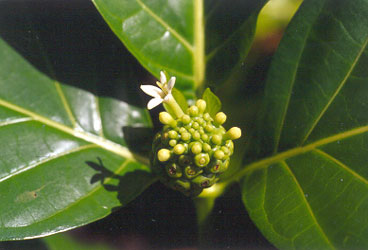 |
Figure 7.
Noni flowers are perfect, having both male and female organs. There
are no male and female noni trees (image: Morinda citrifolia).
|
Question:
Are there varieties of Morinda citrifolia (noni)?
Answer: Yes, there exists significant intra-specific variation in Morinda citrifolia. We recognize three varieties of noni:
1) Morinda citrifolia var. citrifolia, the typical variety. Within this variety, there exist two main types, the large-fruited noni with oval leaves (common in Hawaii) and the small-fruited noni with elongate leaves (common in Micronesia).
a) Large fruited Morinda citrifolia var. citrifolia (noni) with oval leaves:

---------------------------------------------------------------
b) Small-fruited Morinda citrifolia var. citrifolia (noni) with elongate leaves (common in Micronesia, photos: S. Nelson)):
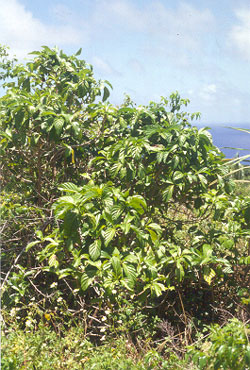 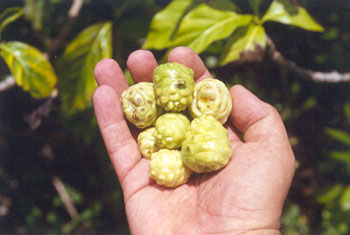
-----------------------------------------------------------
2) Morinda citrifolia cv. 'Potteri', a variegated
noni with green and white leaves is found in Hawai’i.
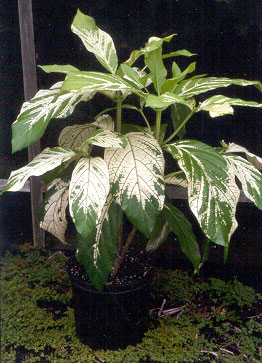 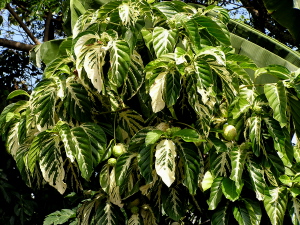
Variegated noni, Morinda citrifolia var. 'Potteri', has green leaves with whitened
areas surrounding leaf veins (photos: S. Nelson).
----------------------------------------------------------------------
3) Morinda citrifolia var. bracteata is found in Indonesia and other parts of the margin between the Indian and Pacific Oceans. Some plants are growing at Lyon Arboretum on the island of Oahu. There are conspicuous bracts subtending the fruits.
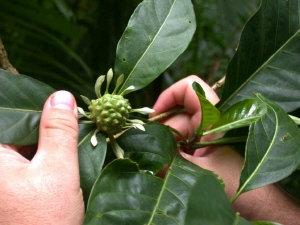
Morinda citrifolia var. bracteata (photo: Dr. Will McClatchey, University of Hawaii at Manoa, Botany Department)
Ref: McClatchey, Will. (2003). Diversity of Uses and Growth Forms in the Morinda citrifolia Complex. Proceedings of the 2002 Hawaii Noni Conference. |

|
|
Last Updated on
December 7, 2006
|
|
|

